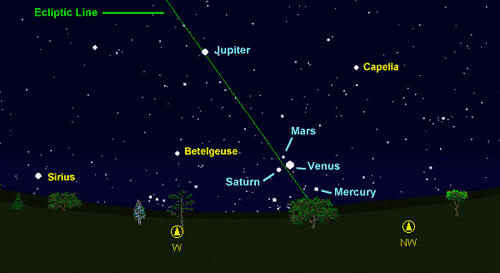On the nights of 5 and 6 May, Mercury, Venus, Mars, Saturn and Jupiter (all the five planets visible from earth with the naked eye) will settle into a configuration that you won't expect to see for about another sixty years. If you look at the western sky soon after sunset on a clear day between now and mid- May, you might get to see Mercury close to the horizon in the west (right above the sunset, provided the sun's leftover rays aren't too bright). And if you keep looking, you will eventually see Venus right above Mercury. Then Mars above Venus, Jupiter a bit further up, and Saturn pretty close and almost collinear with the other four will complete the conjunction by forming a small triangle with Venus and Mars. (See diagram).

The five planets will run across the sky almost parallel to the ecliptic, an imaginary line the sun appears to pass through every year. In reality, the ecliptic is a two-dimensional representation of the plane through which the earth's orbit runs. The ecliptic is an important line also because the twelve zodiac constellations lie on it, which is why their positions change periodically.
Astronomers expect three other configurations of this type in the next hundred years-one in 2040, another in 2060 and the last in 2100. But the groupings in 2040 and 2100 will not be as visible as the one this year, since most of the planets will be barely above the horizon. And even those above may be so close to the horizon that they are too dark to see with the naked eye.
Planet groupings of some sort or another are not uncommon. Every year or two there is some configuration that won't happen for another fifty or hundred years. Configurations in 1997 and in 2000 were the most publicised of recent groupings. The present one is more unusual, however, than either of these previous two. "It is fantastic that so many of these planets will appear in such a small region of sky, all of them will be visible to the naked eye," says astronomy buff Jayanta Acharya of Valmiki Campus. "And this time, the moon is passing through the configuration as well."
But what does all this mean to us? Some of our notoriously fatalistic astrologers have already begun a new rally in the prophecy of apocalypse just as they do every year. In ancient times in Greece and India a bad harvest or royal deaths would probably have been attributed to such a dark night-time planet configuration as this one. But today, despite the many who fancy reading our daily or weekly horoscopes (and believing in them, privately), these prophecies have failed to stir up any public consternation.
 While researching this article, my little brother woke up in the middle of the night to ask, "What if they crash into each other?" My reaction was almost sadistic: "I don't know. Maybe we'll all die."
While researching this article, my little brother woke up in the middle of the night to ask, "What if they crash into each other?" My reaction was almost sadistic: "I don't know. Maybe we'll all die." Luckily, however, the answer to the question is a plain and simple, "They can't." The planets only look close to each other-in reality they aren't. What is actually a three-dimensional space is squashed into a two-dimensional sky when we view it. The planets are pretty far from one another, along a line parallel to our line of vision. We can't see that because we can't see the line or draw it in the sky.
Some people do believe, though, that the net gravitational attraction of these planets might result in earthquakes and tidal waves here on earth. That isn't true either. Science has no reason to believe this, there just isn't any proof that gravity is enhanced through such alignments. So perhaps the only attraction due to "astronomical excitement" is not gravitational, but that of seeing the five bright and beautiful dots that are our neighbouring planets in the solar system shining against the velvet black on 5and 6 May.


